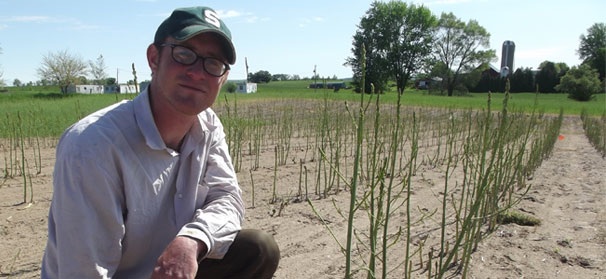

Jul 14, 2011Irrigation experiments continue at MSU asparagus field
At an experimental asparagus field in western Michigan, researchers and students are trying to find the best way to irrigate the perennial crop.
The research being done on the 2.5-acre field in asparagus-rich Oceana County is a collaboration between the state’s asparagus industry and Michigan State University (MSU) personnel, who planted crowns there last year. The researchers are studying more than just irrigation.
Ben Byl, an MSU graduate student, was at the field in late May, installing PVC irrigation tubes with a group of students. Byl, 29, is in the process of finishing school and taking over his family’s asparagus farm in Oceana County. As a grower, he’s interested in observing the results of the irrigation project, which is led by MSU Professor Dan Brainard.
The researchers have separated the field into three sections: one with no irrigation, one with sprinklers and a third with a buried trickle line. The goal is to figure out if irrigation will be fiscally worthwhile for asparagus growers in Michigan. Yield will be the main deciding factor. If irrigation helps growers get better asparagus stands with higher-quality spears that can sell on the fresh market, then they might decide irrigation is worthwhile, Byl said.
According to Brainard, asparagus traditionally is not irrigated in the moist production areas of the Midwest and Northeast. There are periods of drought, however, which, during fern growth, can limit production of the root carbohydrates necessary for high yields the following spring. Drought-stressed plants can be more susceptible to fungal diseases, too, including phytophthora and fusarium – which are increasingly plaguing the asparagus industry.
Although irrigation can provide important benefits, the costs of installation and maintenance run between $1,000-$2,000 per acre, depending on the system used. And irrigation will not increase yields every year. Irrigation systems are an insurance policy against severe drought stresses that might only occur every three or four years, according to Brainard.
Central-pivot irrigation is a proven technology that many asparagus growers already use in other crops. Because of their durability, central-pivot systems can be used after the asparagus crop is gone, in either new asparagus plantings or in other crops like carrots. By wetting the entire soil surface, central-pivot systems are more effective than drip irrigation at cooling the soil, activating certain herbicides and establishing and maintaining cover crops, according to Brainard.
On the other hand, sub-surface drip, or trickle, irrigation has several advantages compared to overhead systems. Drip tubing can be placed in the trench directly below asparagus crowns at the time of planting and left in place for the life of the asparagus. Drip systems deliver water more efficiently than overhead systems and reduce the costs associated with well construction and pumping. In drip systems, water is delivered directly to asparagus roots, weeds are not watered and the potential for exacerbating foliar diseases through leaf wetting is minimized. Drip systems can also be used to deliver fertilizers and pesticides to the crop, according to Brainard.
Byl said trickle technology has advanced quite a bit in the last decade or two. The method is cheaper and more reliable than it used to be.
Although irrigation is likely to be an important tool for asparagus production systems of the future, many questions remain about how best to optimize such systems. MSU’s trial comparing the effects of sub-surface drip and overhead irrigation on asparagus yield and profitability is a long-term project, according to Brainard.
MSU researchers also are studying the efficacy of chemigation in the experimental asparagus field. They’re comparing the efficacy of chemigation, foliar sprays and in-furrow applications of insecticides, to see which best protects young plants from pests such as asparagus miner and asparagus beetle, according to Zsofia Szendrei, MSU’s vegetable entomologist.
Whatever the results of the projects, they won’t come quickly. It might be 2015 before the researchers feel comfortable enough to make any recommendations, said John Bakker, executive director of the Michigan Asparagus Advisory Board.
By Matt Milkovich














